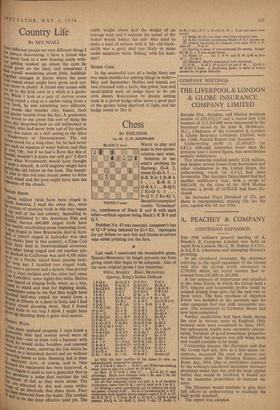Chess
BY PHILIDOR No. 48. C. W. SHEPPARD BLACK (5 men)
WHITE (7 men)
WHITE to play and mate in two moves: solution next week.
Solution to last week's problem by Hartong: Q-K 2, threat Q-Kt 4. 1 ... B-K B 6; 2 R-B 4.
1 . • • R-B 6; 2 Q-K 4.1 ...B-Q 5; Problem No. 45 was unsound, composer's key of Qx P being defeated by Ktx Kt. Apologies for my failure to spot this and thanks to solvers who wrote pointing out the flaw.
Last week I mentioned the remarkable game, Spassky-Bronstein: its length prevents me from giving notes that begin to be adequate. One of the most original games I can remember.
White, SPASSKY Black, BRONSTEIN Opening-, King's Indian Defence
1 P-Q 4 Kt-K B 3 25 P-B 4 P-K $ 2 P-Q B 4 P-K Kt 3 26 Kt-B 3 Kt-K 2
3 Kt-Q B 3 11-Kt 2 27 R-K 1 (g) Q R-K 13 1 4 P-K 4 P-Q 3 28 P-Kt 4 P-B 3 (h)
5 P-0 3 P-K 4 29 Kt x P 11 x Kt 6 P-Q 5 Kt-R 4 (a) 30 R (4) x B Kt x Q P 7 B-K 3 Kt-R 3 31 R-K 8 Kt (3)-13 2 (i) 8 Q-Q 2 Q-R 5 ch 32 R x Rch K x R 9 P-Kt 3 (b) Kt x P 33 K-R I R-11 4 (J) 10 Q-B 2 Kt x B 34 Q-R 4 Kt-B 3
11 Q x Q Kt x 13 35 Q-B 2 Kt-Kt 4 12 K-B 2 (c) Kt x B P 36 Q-K 2 Kt-Q 4 13 P-Kt 3 Kt-Kt 3 37 P-R 6 (k) P x P
14 K Kt-K 2 P-K 134 38 Q-K 8 ch K-Kt 2 15 K R-K Kt o-o 39Q x P K-R 3 16 K-Kt 2 11-Q 2 40 Q x RP Kt x Kt P 17 P-R 4 (d) B-K 133 41 Q-Kt 7 Kt-Q 6 18 Q-Kt 3 Kt-Kt 5 42 R-K 7 Kt x P 19 P-R 5 Kt-B 1 43 R x P ch K-Kt 4
20 P x P B x P (r) 44 Q-K 7 ch K-Kt 5 21 R-R 4 Kt-Q 6(f ) 45 Q-K 3 K-Kt 4
22 R-Q B 4 Kt-114 46 P-R 4 ch K-Kt 5
23 Kt-K 4 Kt-R 3 47 K-R 2 Kt-R 4
24 Kt x Bch It x Kt 48 R-R. 6 Resigns (I) (a) With the later sacrifice of the queen in view, an extraordinarily imaginative concept. (h) If 9 B-132, then 9 0-13 5; and White has nothing bettor than to play for a draw by 10 B-K 3. (c) Best. If 12 Q-B 2, then 12 . . . Kt-Q Kt 51 with advantage. Black now emerges with 2 Bs. and 2 Ps. for queen and good attacking chances. (d) All this ultimately turns out well; it is of doubtful correctness: better first K-R I and Q back to B 2 or K 1. (e) Missing a great opportunity (as he pointed out after the game). Correct is 20... Kt-K 21 threatening Kt x B P. whereupon both knights join in attack—and if 21 P x P?, Kt-13 4; 22 P x P d.ch. K-R 1; 23 Q-K 1 (Q-B 2 loses queen), Kt-Q 6; 24 Q-Q 2, Kt-R 5 oh; 25 K-Kt 3, R-Kt 1 chi; 26 P x ch, R x Q ch and mate next move I (f) Better Kt-R 3 at once: text loses valuable time. (g) R-0 1 is better, preventing Black's P-li 3 manoeuvre. (ii) Greatly improving his chances: if in reply 29 P x P, then 29 . . . P-Q 4! (1) Starting a series of over-elaborate Kt moves. Simply Kt (R. 3) x P was much better.
(J) Better 33 . . . Kt x B P; and if 34 Q-14. 4, then 34 . Kt-R 4.
(k) Decisive: Black's position is now shattered. (I) If 48 ... R-B 3; 49 Q-Kt 5 ch and if 48 ... Kt-II 5; 49 Q-Kt 3 mate. A fascinating game, in spite or errors caused by its great difficulty.










































 Previous page
Previous page